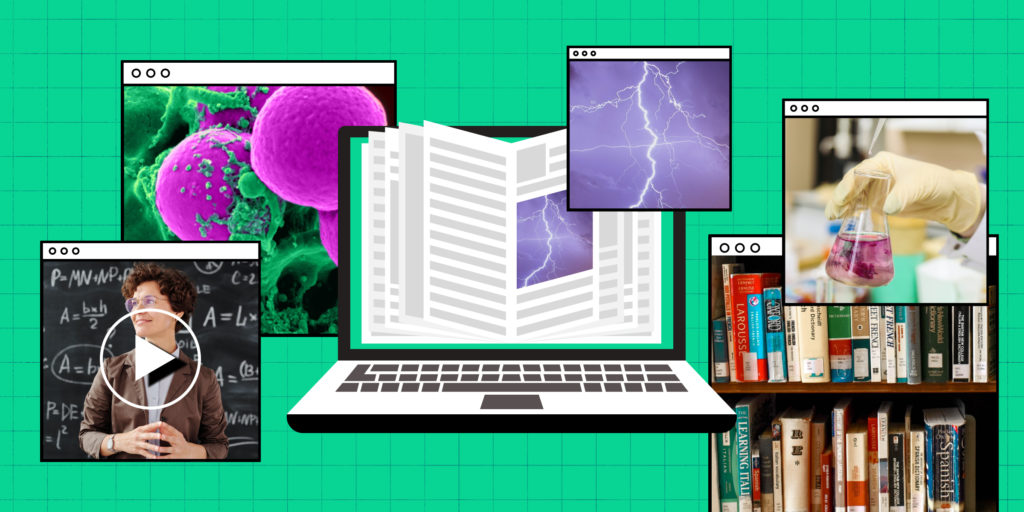Eighty percent of university students don’t read their assigned textbook chapters before class.1 The majority of students grew up with interactive content at their disposal. So it’s no wonder that having the same interactivity in their course materials, and being able to access their resources in one place, is a non-negotiable.
There’s no doubt that print textbooks are still widely listed on class syllabi. In recent years, more faculty are questioning how effective print textbooks are in setting students up for academic success. These static textbooks present four core challenges.
- Inability to easily customize: Examples and illustrations are static and may not be relevant to your particular class or students. In addition, students pay for an entire textbook, even if you only use half or have to supplement with additional materials.
- Treating accessibility as an afterthought: Many print books come with a hefty price tag and little-to-no tailored support in the form of screen reader integration, alternative text or high-contrast multimedia for students with disabilities.
- Little insight into comprehension or completion: Instructors also have little insight into whether students are ‘getting it’ or if they’re even completing assigned readings. On the other hand, students have little indication of where to focus their future study efforts.
- A passive reading experience: Long-form textbooks don’t engage students deeply in the learning process, treating them as passive consumers of course material.
Here are some key reasons why dynamic, interactive content is the way forward.
The ability to customize, anytime and anywhere
Students want content that’s current and reflective of our ever-changing world. The ability to customize content with Top Hat is a game changer. If you come across a viral article or a trending case study from last weekend, simply add it into your text. You might add 3D simulations that let students revolve chemical structures or anatomical protein cells using their cursor. Christine Kelly, Professor and Assistant Chair of the Department of Biology and Chemistry at County College of Morris, is among the many STEM faculty who have converted printed lab materials to Top Hat’s digital-first platform. “Customization was a huge deal for us,” she says. “I was given tutorials on how to edit my master shell. I now fix procedures, address student mistakes and make iterations before publishing for the new semester,” Kelly says.
This combination of reading, watching, and doing is one of many evidence-based practices to keep learners actively engaged in and out of class.2 Students couldn’t agree more. More than three quarters of learners who use a Top Hat Interactive eText state that their content is more engaging than other digital platforms they have used.3
In the video below, Brad Cohen, Chief Academic Officer at Top Hat, outlines how our content customization, representation and rich insights empowers educators and students alike.
Designing content with inclusion in mind
Sixty-seven percent of students say it’s important that they see individuals who represent their own identity included in their learning materials. With Top Hat, you can customize material to ensure students see more of themselves and their communities reflected in what they read.
Gordana Lazic, Basic Course Director in the Department of Communication, Media and Journalism at Missouri State University, enjoys using Top Hat’s Inclusive Public Speaking eText given the emphasis on DEI. “In our intersectionality unit, students complete a land acknowledgement activity. They’re asked to research where they’re situated, take a screenshot, and upload this to Top Hat. It’s a way of acknowledging where they’re situated while reflecting on their own identity,” Lazic shares.
Here are a few ways our Interactive eTexts set a new standard when it comes to accessibility.
- Enable a mobile-first reading experience: Students may access their text from their preferred device, making it easy to read on the go. All Top Hat Interactive eTexts are also compatible with screen readers.
- Accommodate learners with alternative text: Provide alternative text on images in chapters and assignments, allowing all students to engage equally with your material.
- Slash financial obstacles: Students no longer need to purchase individual platform subscriptions for their textbook, chapter polling and homework assignments. In combining readings with low-stakes assessments and multimedia, students are now more inclined to complete their chapters as all information is aggregated in one central location.
“It’s a heaven of information because I can access the textbook, tutorial questions, homework and textbook questions with answers. Top Hat is the best all in one package out there.”
A student from Top Hat’s fall 2023 survey.
Taking frequent pulse checks on student comprehension
Are students reading their assigned chapters before class? What portion of your embedded assignments are they tackling? With Top Hat’s digital-first content solutions, you can review real-time insights into student progress and comprehension for any reading or assignment. In fact, 86 percent of students who use a Top Hat Interactive eText say our digital-first content experience helped them understand their course material better.4 This is in large part due to the instant, automatically-generated feedback students receive on their progress.
Make your content interactive and deepen understanding by adding short-form discussions, click-on-target questions, or even low-stakes quizzes that build off embedded media in your text. Mary Blakefield, Associate Professor of Biology at Indiana University East, found that comprehension rates soared after converting her printed Biology lab manual to a Top Hat Interactive eText. “After using this lab manual, I was able to identify specific knowledge gaps. I could put in more practice questions to shore up weaker areas. Now, a higher percentage of students are answering correctly,” she says.
Whether it is designing custom assignments or adapting an existing digital textbook, Top Hat’s team of instructional designers will guide you toward a more dynamic teaching and learning experience. One that will help students see themselves as part of a broader learning community. One that will ensure you and your students receive the tailored insights needed to excel. And one that will surely get students even closer to reaching their professional aspirations. Explore our personalized content solutions now.
References
- Zeivots, S. (2021). Up to 80% of uni students don’t read their assigned readings. Here are 6 helpful tips for teachers. The Conversation. https://theconversation.com/up-to-80-of-uni-students-dont-read-their-assigned-readings-here-are-6-helpful-tips-for-teachers-165952
- Reuell, P. (2019). Lessons in learning. The Harvard Gazette. https://news.harvard.edu/gazette/story/2019/09/study-shows-that-students-learn-more-when-taking-part-in-classrooms-that-employ-active-learning-strategies/
- Top Hat. (2023). [Unpublished raw data on student feedback from fall 2023].
- Ibid.


